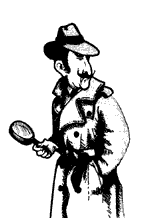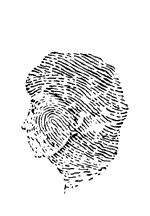|
Several books explore how footprints can be used as clues to
the identities of the animals who left them. The rest of the books
are mysteries, some of which involve the technique of fingerprinting.
Like those books under Crime Lab Chemistry, these mysteries all
involve the discovery of evidence and its subsequent analysis
to make inferences.
Some teachers use newspaper articles with their students, which
describe a crime (usually unsolved), the evidence and some possible
inferences. There are books containing nonfiction accounts of
mysteries or scientific discoveries, in which detective-like behavior
was required. Such a mystery would be particularly apt if it
involved fingerprinting or even what’s currently called DNA
fingerprinting. See also the books on classification in the Math
Strand section on Logic.
Cam Jensen and the Mystery of the Gold Coins
Chip Rogers: Computer Whiz
From the Mixed-Up Files of Mrs. Basil E.
Frankweiler
The Great Adventures of Sherlock
Holmes
Let’s Go Dinosaur Tracking
The Mystery of the Stranger in the Barn
The One Hundredth Thing About Caroline
Susannah and the Blue House Mystery
Susannah and the Poison Green Halloween
Who Really Killed Cock Robin?
Whose Footprints?
Cam Jensen and the Mystery of the Gold
Coins
by David A. Adler; illustrated by Susanna Natti
Viking Press, New York. 1982
Dell Publishing, New York. 1984
Grades: 3–5
Cam Jensen uses her photographic memory to solve a theft of
two gold coins. Cam and her friend Eric carry around their 5th
grade science projects throughout the book and the final scenes
take place at the school science fair. (Other titles in the series
include Cam Jensen and the Mystery at the Monkey House
and Cam Jensen and the Mystery of the Dinosaur Bones in
which she notices that three bones are missing from a museum’s
mounted dinosaur.)
Return to title list.
Chip Rogers: Computer Whiz
by Seymour Simon; illustrated by Steve Miller
William Morrow, New York. 1984
Out of print
Grades: 4–8
Two youngsters, a boy and a girl, solve a gem theft from a
science museum by using a computer to classify clues. A computer
is also used to weigh variables in choosing a basketball team.
Although some details about programming the computer may be a
little dated, this is still a good book revolving directly around
sorting out evidence, deciding whether or not a crime has been
committed, solving it, and demonstrating the role computers can
play in human endeavors. By the author of the Einstein Anderson
series.
Return to title list.
From the Mixed-Up Files of Mrs. Basil
E. Frankweiler
by E.L. Konigsburg
Atheneum, New York. 1967
Dell Publishing, New York. 1977
Grades: 5–8
Twelve-year-old Claudia and her younger brother run away from
home to live in the Metropolitan Museum of Art and stumble upon
a mystery involving a statue attributed to Michelangelo. This
book is a classic, and has been recommended to GEMS by many teachers.
Return to title list.
The Great Adventures of Sherlock Holmes
by Arthur Conan Doyle
Viking Penguin, New York. 1990
Grades: 6–Adult
These classic short stories are masterly examples of deduction.
Many of the puzzling cases are solved by Holmes in his chemistry
lab as he analyzes fingerprints, inks, tobaccos, mud, etc. to
solve the crime and catch the criminal. Nearly every Sherlock
Homes story is suitable for this GEMS guide. These stories are
available from many different publishers and in many editions.
Return to title list.
Let’s Go Dinosaur Tracking
by Miriam Schlein; illustrated by Kate Duke
HarperCollins, New York. 1991
Grades: 2–5
The many different types of tracks dinosaurs left behind and
what these giant steps reveal is explored. Was the creature running
… chasing a lizard … browsing on its hind legs for leaves
… traveling in pairs or in a pack … walking underwater?
At the end of the book, you can measure your stride and compare
the difference when walking slowly, walking fast, and running.
The process involved in attempting to draw conclusions about an
animal’s behavior or movement patterns from its tracks is
similar to the way inferences are drawn from evidence in the GEMS
mystery-solving activities. You could discuss with your students
how they would weigh the evidence and consider the suspects if,
for example, muddy shoeprints of a suspect had also been found
at the scene of the crime.
Return to title list.
The Mystery of the Stranger in the
Barn
by True Kelley
Dodd, Mead, & Co., New York. 1986
Grades: K–4
A discarded hat and disappearing objects seem to prove that
a mysterious stranger is hiding out in the barn, but no one ever
sees anyone. A good opportunity to contrast evidence and inference.
Return to title list.
The One Hundredth Thing About Caroline
by Lois Lowry
Houghton Mifflin, Boston. 1983
Dell Publishing, New York. 1991
Grades: 5–9
Fast-moving and often humorous book about 11-year-old Caroline,
an aspiring paleontologist, and her friend Stacy’s attempts
to conduct investigations. Caroline becomes convinced that a neighbor
has ominous plans to “eliminate” the children and Stacy
speculates about the private life of a famous neighbor. Due to
hasty misinterpretations of real evidence, both prove to be wildly
wrong in their inferences. Gathering evidence, weighing it, and
deciding what makes sense are good accompanying themes. A somewhat
inaccurate portrayal of “color blindness” is a minor
flaw.
Return to title list.
Susannah and the Blue House Mystery
by Patricia Elmore
E.P. Dutton, New York. 1980
Scholastic, New York. 1990
Grades: 5–7
Susannah (an amateur herpetologist) and Lucy have formed a
detective agency. They check into the death of a kindly old antique
dealer who lived in the mysterious “Blue House.” They
attempt to piece together clues in hopes of finding the treasure
they think he has left to one of them. The detectives evaluate
evidence, work together to solve problems, and prevent a camouflaged
theft from taking place.
Return to title list.
Susannah and the Poison Green Halloween
by Patricia Elmore
E.P. Dutton, New York. 1982
Scholastic., New York. 1990
Grades: 5–7
Susannah and her friends try to figure out who put the poison
in their Halloween candy when they trick-or-treated at the Eucalyptus
Arms apartments. Tricky clues, changing main suspects, and some
medical chemistry make this an excellent choice, with lots of
inference and mystery.
Return to title list.
Who Really Killed Cock Robin?
by Jean Craighead George
HarperCollins, New York. 1991
Grades: 3–7
A compelling ecological mystery examines the importance of
keeping nature in balance, and provides an inspiring account of
a young environmental hero who becomes a scientific detective.
Return to title list.
Whose Footprints?
by Masayuki Yabuuchi
Philomel Books, New York. 1983
Grades: K–4
A good guessing game for younger students that depicts the
footprints of a duck, cat, bear, horse, hippopotamus, and goat.
Return to title list.
|


|


